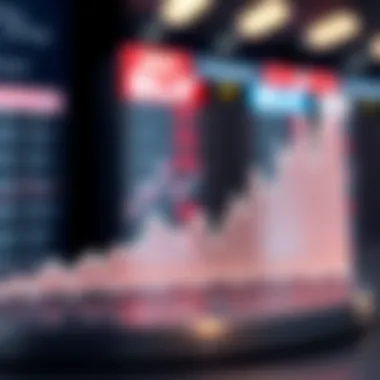Current Insights on SLV Price Trends


Intro
The silver market has always been a fascinating space for investors, traders, and analysts alike. Today, the focus is squarely on the price of SLV, which is the Silver Trust ETF. Understanding its dynamics is crucial for anyone involved in silver investments. Not only does it reflect current market conditions, but it also reveals underlying economic and geopolitical nuances that can influence prices globally. In this exploration, we will dissect the elements shaping SLV's price right now, ranging from immediate market trends to investment strategies that could guide decision-making.
Market Trends and Analysis
Current Market Overview
As of late, the SLV price has shown fluctuations, reflective of broader economic indicators and geopolitical uncertainties. The recent price movements are not occurring in a vacuum; they echo the undercurrents of global economics. Markets are sensitive to shifts in interest rates, inflation reports, and currency exchange rates. With central banks around the world adjusting their monetary policies, the silver market is navigating through some choppy waters.
World events, such as political unrest or trade negotiations, also leave their mark on SLV prices. Investors are motivated by the safe-haven appeal of silver during turbulent economic times. This has led to increased trading volumes, as more retail and institutional investors pour capital into silver, prompting shifts in market pricing.
Key Indicators and Metrics
To truly grasp the current state of SLV prices, one should consider several key indicators:
- Spot Silver Prices: Tracking discrepancies between SLV prices and basic silver spot prices can highlight premium shifts.
- U.S. Dollar Value: Often inversely correlated, fluctuations in the dollar's strength can significantly affect silver demand. A weaker dollar generally boosts silver prices.
- Interest Rates: As bond yields rise, silver may fall from grace temporarily, as investors shift focus to higher returns.
- Geopolitical Events: Tensions or conflicts can lead to spikes in silver demand as a protective asset.
"Understanding SLV's pricing dynamics involves more than just looking at the numbers—it's about reading the market's sentiment and the global narrative surrounding it."
Armed with this knowledge, investors can more effectively navigate the complexities of SLV trading.
Investment Strategies
Long-term vs Short-term Strategies
When it comes to investing in SLV, one must determine their approach—long-term or short-term. Long-term investors might look at silver as a hedge against inflation and economic downturns, seeking to ride out short-term volatility. On the contrary, short-term traders often capitalize on market fluctuations, looking for opportunistic buys and sells based on real-time news.
- Long-term Hold: Favorable for investors who view silver as part of their retirement portfolio or wealth preservation strategy.
- Quick Trades: Perfect for those with a keen eye on market trends and the ability to react promptly to news/events.
Risk Management Techniques
Effective risk management is paramount when dealing with commodities like silver. Here are a few techniques investors often employ:
- Diversification: Invest across various assets. Don’t put all eggs in one basket.
- Utilizing Stop-losss: Setting predefined points where you'll exit a trade can protect against significant losses.
- Regular Assessment: Keep track of market trends, economic indicators, and personal investment goals. This helps in making informed decisions.
In summary, whether you aim for a long-term hold or prefer the thrill of quick trades, understanding the market dynamics, navigating risks, and keeping an eye on geopolitical influences can greatly enhance your success in the silver market. For further insights, consider resources like Investopedia or CoinDesk, which provide market updates and historical context that can inform your investment decisions.
Understanding SLV
Understanding the nature and functionality of SLV, which stands for the iShares Silver Trust, is crucial for anyone delving into the silver investment landscape. It's not just another financial instrument; rather, it serves as a bridge for investors to access the silver market without the complications of physically handling the metal. This article examines SLV, its significance, and its interactions within broader economic environments.
Grasping the ins and outs of SLV can empower investors, whether they're seasoned pros or novice traders, to make informed decisions. Here are a few key elements and benefits of understanding SLV:
- Direct Exposure: SLV offers a way to gain exposure to silver prices with ease. Instead of purchasing physical silver bars or coins, investors in SLV simply trade shares in the fund, which directly tracks the price of silver.
- Liquidity: Trading SLV shares is significantly easier than buying or selling physical silver. Investors can buy or sell shares easily through stock exchanges, adding an extra layer of convenience.
- Accessibility: For individuals who may not have the means or desire to purchase physical silver, SLV provides an investment opportunity that is readily available through brokerage accounts.
- Transparency: SLV's operations are regulated, and the assets backing the fund are constantly monitored. This transparency can provide reassurance to investors looking to place their trust in the product.
When considering SLV, it’s essential to reflect on how the global economic and political environment can affect silver prices. Factors such as inflation rates, interest rates, and even geopolitical tensions can create ripples in SLV's pricing and, by extension, influence investors' strategies.
Overall, the understanding of SLV encompasses recognizing both its opportunities and its risks. It's a nuanced topic, but essential for anyone aiming to navigate the complexities of silver investments effectively.
Factors Influencing SLV Price


Understanding the factors that influence SLV's price is crucial for anyone involved in trading or investing in silver. Navigating the complexities of the silver market requires more than just a basic grasp of supply and demand; it necessitates an awareness of global economic indicators, geopolitical events, and market dynamics. Each of these factors can drastically shift SLV's valuation in a short span, thereby affecting investor strategies and market sentiment.
Global Economic Indicators
Global economic indicators play a significant role in determining the price of SLV. These metrics provide insights into the overall health of economies around the world. Key indicators include:
- Inflation Rates: When inflation rises, investors typically flock towards precious metals like silver as a hedge against currency devaluation. This phenomenon often leads to an uptick in SLV prices.
- Interest Rates: Low interest rates generally make SLV more attractive. Investors seek alternatives to traditional savings, thus driving up demand for silver assets.
- Unemployment Rates: High unemployment may signal economic distress, prompting safe-haven buying in the precious metals market.
The interplay of these indicators informs market sentiment and helps speculators position themselves effectively. For example, if a major economy publishes unexpectedly high inflation rates, it could drive investors to acquire SLV in anticipation of future price increases.
Geopolitical Events
Geopolitical happenings can also significantly impact SLV prices. Events such as conflicts, trade wars, and political instability often create uncertainty in financial markets. Investors typically respond to crises by moving their capital into safer assets like silver. Here are some examples of how geopolitical factors can sway SLV:
- Wars and Conflicts: Tensions in regions rich in natural resources, such as the Middle East, often lead to volatility in markets. Investors may turn to SLV as a means to safeguard their wealth during tumultuous times.
- Trade Policy Changes: Adjustments in trade agreements or tariffs can provoke fluctuations in silver prices. For instance, sudden trade restrictions might limit the supply of silver, hence driving prices up.
- Government Instability: Political turmoil can prompt a flight to safety. Even a rumor about a country’s leadership crisis can cause speculators to scoop up SLV, anticipating a potential surge in its value.
A notable example of this was observed during previous global crises, when SLV often surged amidst escalating tensions in international relations, signifying its status as a safe haven.
Supply and Demand Dynamics
At the heart of SLV pricing lies the fundamental principle of supply and demand. The interaction of these two elements dictates market prices. Here are some elements to consider:
- Mining Production: Fluctuations in silver mining output can lead to significant shifts in SLV pricing. Decreasing production due to operational costs or depletion of mines can tighten supply, thus increasing prices.
- Industrial Demand: Silver has extensive industrial applications, from electronics to solar panels. An upsurge in demand in these sectors can positively influence SLV prices.
- Investment Demand: The popularity of silver as an investment vehicle has surged, particularly during uncertain economic times. ETFs like SLV draw in investors looking to gain exposure to silver without holding the physical metal.
In recent years, we have seen how technological advancements and changing energy policies invigorate industrial demand, impacting SLV. This intricate balance demands constant monitoring from investors trying to gauge where prices might head next.
"Understanding the interplay of these factors enables investors to make informed decisions about their SLV positions" - Expert Analyst
In summary, comprehending the factors that influence SLV pricing is not merely academic; it is essential for anyone looking to grasp the nuances of the silver market. Keeping a pulse on global indicators, geopolitical shifts, and the basic laws of supply and demand can make a substantial difference in investment outcomes.
Current SLV Price Trends
Understanding current trends in the price of SLV is crucial for anyone looking to navigate today’s volatile market. The trends not only reflect immediate market sentiments but also shape investor strategies and decisions. In a landscape where silver investment fluctuates on various external factors, keeping an eye on SLV pricing offers valuable insights for potential buyers and seasoned traders alike. By examining real-time pricing data and comparing it to historical data, investors can better position their assets and create informed strategies. This section peels back the layers on SLV pricing, aiding everyone who’s keen on making judicious investment choices.
Latest SLV Pricing Data
As of today, SLV is trading at approximately $*25.50 per share. This price represents a slight uptick from previous weeks, which indicates a moderate recovery trend in the silver market overall. Investors often track SLV closely since it serves as a trading vehicle that reflects not just silver prices but also investor confidence in economic stability.
While some market analysts keep an eye on the broader commodity trends, others focus on technical indicators to spot buying and selling opportunities. SLV pricing data can be very useful to gauge market momentum. For instance, you might notice that recent increased trading volumes coincide with price growth, suggesting that more investors are looking to enter the market. Factors such as inflation rates, currency values, and reports from various financial markets impact SLV’s pricing, making continuous tracking indispensable.
- Recent pricing trends highlight the following:
- The volatility of SLV due to economic shifts
- Correlation with spot silver prices
- Impact of geopolitical events on investor sentiment
Investors should keep a close watch on these ongoing changes and adjust their trading strategies accordingly.
Price Comparisons with Historical Data
The importance of comparing current SLV prices with historical data cannot be overstated. Historical data reveals long-term trends and cyclical patterns that are essential for making predictions. For instance, looking back over the past year, SLV once climbed to as high as $28.75 before settling back down as market conditions evolved. This sharp rise was largely fueled by a perfect storm of economic anxiety and inflation worries, showcasing how sensitive SLV is to global economic signals.
When comparing today’s prices to those during major economic shifts—such as the 2020 pandemic fluctuations or the 2008 financial crisis—we see a recurring theme: silver often acts as a safe-haven asset during turbulent times. Here are some key comparisons:
- 2021 Peaks: SLV reached around $27 in early 2021, while seeing a price drop immediately after as the market adjusted.
- 2008 Financial Crisis: SLV hit approximately $20 during this period, showcasing significant growth potential in uncertain economic climates.


"Historical price patterns indicate that SLV often rises during times of economic crisis, but corrections can be sharp as markets stabilize."
This information serves as a lesson for those aiming for long-term investments in SLV. Understanding the price trends helps illustrate the potential risks and rewards, guiding investors toward more strategic decision-making.
SLV and the Broader Silver Market
Understanding the relationship between SLV and the broader silver market is crucial for both seasoned and novice investors alike. The dynamics at play in this market can have significant impact on investment decisions, risk management, and potential returns. SLV, or the Silver Trust, is not just a mere vehicle for investing in silver; instead, it acts as a reflection of various economic and geopolitical factors that influence the actual market.
When investors decide to engage with SLV, they are, in fact, tapping into the larger picture of silver trading. Notably, the SLV price often mirrors spot silver prices, but with some distinctions that merit attention. The fund tracks the price of silver, making it important to understand how variations in spot prices affect SLV's performance. Regular fluctuations can arise from changes in demand, production costs, and external events, causing ripples in how SLV is perceived as an investment.
Comparison with Spot Silver Prices
SLV is designed to track the spot price of silver as closely as possible, yet its value may occasionally diverge from live market rates. This discrepancy can stem from several factors:
- Management Fees: SLV charges management fees that can erode returns over time if the silver price stagnates or declines.
- Liquidity Issues: In times of heightened volatility, liquidity can behave oddly. Large volumes of buying or selling in SLV can create a lag in price responses when compared to spot prices.
- Market Perception: Investor sentiment and speculation can greatly affect SLV prices as well. If the market outlook is bullish on silver, SLV may trade at a premium to spot prices, and conversely, during bearish phases, it could trade at a discount.
Therefore, when assessing SLV versus spot silver prices, it is always wise to remain cognizant of the broader implications of any divergence.
Effects of Market Sentiment
Market sentiment is another critical element influencing SLV. Often, it acts like a tide that raises or lowers all boats in the silver investment harbor. Positive sentiment can lead to increased inflows into SLV, pushing the prices up even if underlying spot prices aren’t necessarily climbing at the same rate. Conversely, negative perceptions can spark a wave of selling pressure.
Several factors can shape market sentiment regarding silver and the SLV:
- Economic Indicators: Data releases on inflation, employment, and GDP can skew how investors feel about the future of silver prices.
- Geopolitical Situations: Crises or instability can often lead traders to flock to silver as a safe haven asset, inflating SLV prices regardless of prevailing economic conditions.
- Industry News: Developments in mining, technological advancements, or changes in demand from sectors like electronics can also affect how investors feel.
Thus, the sentiment surrounding SLV is not solely about the fundamental dynamics of silver; it is a multi-faceted issue that intertwines with global events, economic forecasts, and investor psychology.
"Understanding SLV in the context of broader silver market movements allows investors to make more informed decisions based on expected trends and underlying data rather than just gut feelings or surface reactions."
Investment Strategies Involving SLV
Investment strategies related to SLV, or the iShares Silver Trust, play a significant role in the overall landscape of silver investments. Given how silver is regarded as a reliable hedge against inflation and market volatility, understanding various tactics can yield favorable outcomes for both new and seasoned investors. Recognizing the specific elements and considerations in SLV investment illuminates the path to making informed decisions, mitigating risks, and maximizing potential gains.
Short-term Trading Tactics
Short-term trading with SLV can be an intense process, akin to trying to catch a greased pig. Investors adopting this strategy often aim to capitalize on market fluctuations that occur in the short-term, benefiting from price volatility. This requires an astute understanding of technical analysis—charts, patterns, and indicators become your best pals. Traders usually closely observe the following:
- Moving Averages: These can highlight trends and identify potential entry and exit points.
- Momentum Indicators: Tools like the Relative Strength Index (RSI) may offer insights into overbought and oversold conditions.
- Catalyst Events: Economic data releases or geopolitical news can spur rapid price movement, making timing essential.
Active traders often set tight stop-loss orders to limit losses and keep profit margins healthy. Thus, it’s crucial for those considering short-term trading to have a game plan while remaining flexible enough to adapt to shifting market sentiments.
Long-term Holding Considerations
On the flip side, long-term holding strategies appeal to those whose investment philosophy leans toward stability and appreciation over time. SLV can serve as a storage vessel for wealth in uncertain times. This strategy often includes:
- Understanding Silver's Historical Value: Recognizing how silver has performed during past economic crises can enlighten future expectations.
- Dollar-Cost Averaging: Investors may choose to invest a fixed amount in SLV at regular intervals, which spreads out the risk against fluctuations in prices.
- Watching MarketCycles: Observing trends over a longer horizon may provide insights into when the right time to buy or sell is.
Nevertheless, this approach does require patience, as market cycles can take time to unfold, and dividends, if applicable, often aren’t immediate.
Risk Management Approaches


Whichever strategy one chooses, risk management remains a vital cornerstone in the investment process. The silver market can be notoriously volatile, and without proper risk management, investors may face significant losses. Some strategies to mitigate risk include:
- Diversification: Blending SLV with other assets in a portfolio can provide balance and reduce the average risk exposure.
- Setting Stop-Loss Orders: As mentioned for short-term tactics, these orders can automatically sell SLV when it dips to a certain price, protecting the investor from further loss.
- Regularly Reviewing Investments: Keeping a steady pulse on market conditions and one's investment performance enables timely adjustments.
"Investment in SLV isn’t just a numbers game; it’s about understanding the landscape and your role in it."
In summary, whether opting for aggressive trading or a more measured holding stance, it's essential to know that each strategy carries its own benefits and pitfalls. By embracing sound investment principles within the context of SLV, investors can potentially enhance their financial well-being and navigate through the complexities of silver investment effectively.
Future Projections for SLV Pricing
Understanding future projections for SLV pricing is crucial for investors. This section not only highlights potential price movements but also delves into the factors that could support those shifts. Market predictions can serve as a guiding compass, aiding individuals in making informed decisions about their investments in silver. By grasping these forecasts, one can better navigate through the complexities of the SLV market while mitigating risks associated with volatility. Moreover, assessing future projections allows investors to position themselves advantageously in a constantly evolving marketplace.
Experts' Market Forecasts
Predictions from seasoned experts in the field can provide a wealth of insight into possible SLV price trajectories. Various financial analysts and market specialists contribute their opinions based on extensive research and historical data.
- Demand Dynamics: Should industrial demand for silver—particularly in technology and renewable energy—continue to grow, it could push prices higher.
- Inflation Concerns: Many experts tie silver prices closely to inflation. As central banks print more money, the anticipated inflation may urge more investors to flock to silver as a safe haven, drawing attention to SLV gold investments.
- Geopolitical Stability: The current geopolitical landscape is unpredictable. Markets react based on tensions, and should there be escalations, SLV may be positioned to gain as a protective asset.
A multitude of financial news platforms regularly provide such forecasts. For a glimpse into analysts’ insights, sites like Bloomberg and CNBC often carry reports covering expert forecasts.
Analytical Models and Predictions
Diving deeper into the future, analytical models offer a structured approach to forecast SLV pricing. These models utilize various types of data to make educated predictions.
- Technical Analysis: By studying past price movements and identifying patterns, traders can develop insights on potential future pricing, often relying on performance indicators like moving averages and Bollinger Bands.
- Fundamental Analysis: Here, analysts evaluate silver's intrinsic value based on economic indicators such as supply-demand equations, mining production rates, and macroeconomic balance. For instance, a surge in silver mining output might influence quantities available in the market and thus affect prices.
- Sentiment Analysis: Often, patterns generated through social media trends and news can serve as indicators for short-term movements. Surveillance of platforms like Reddit and Twitter can sometimes reveal shifts in investor sentiment before movements show in traditional markets.
A good resource to understand the detailed mechanics behind these analytical methods can be found at Investopedia.
In summary, while projections aren't guarantees, they serve as valuable tools for developing strategies around SLV investments. Evaluating expert insights alongside robust analytical models provides investors with a layered understanding of market dynamics and potential directions. This kind of foresight is necessary in dodging pitfalls and capturing opportunities in the fluctuating world of SLV.
"Understanding the past is as important as predicting the future in market strategies."
By being aware of these forecasting tools, investors can secure themselves a better position, prepared for what lies ahead in the realm of SLV.
End
As we wrap up this exploration of SLV pricing and its intricate web with the ever-shifting dynamics of the silver market, it becomes clear that understanding SLV is more than just following a number on a screen. Investors should pay attention to several nuanced factors that influence not only pricing but also their investment strategies.
The significance of SLV, or Silver Trust, cannot be overstated. It acts as a conduit not only for retail investors like you and me, but also for larger institutional players. With SLV's increasing relevance in the financial spectrum, the ultimate question remains: how do you integrate it into your portfolio effectively?
In this article, we covered a lot of ground—from the historical context of SLV prices to the latest trends and their implications for future pricing. Let’s take a moment to reiterate some of key takeaways:
Summary of Key Points
- Market Influence: SLV is heavily impacted by global economic indicators and geopolitical events, making it vital to stay updated on these fronts.
- Dynamic Valuations: Current SLV prices show significant deviations from historical averages, signaling potential opportunities or risks for investors.
- Investment Strategies: Both short-term and long-term strategies can yield different results based on prevailing market conditions. Understanding risk management approaches is crucial to sustaining your investment.
- Future Trends: Experts' market forecasts emphasize ongoing volatility but also reveal potential upward trends. Awareness of these forecasts helps in making informed decisions.
Final Thoughts on SLV Investment
Navigating the SLV landscape requires both diligence and a dash of intuition. While prices may fluctuate with market sentiment, a knowledgeable investor can carve out a niche in this chaotic environment. The world of SLV is rife with possibility, but it demands careful analysis and a willingness to adapt to changing market forces.
By embracing a multifaceted understanding of factors influencing SLV prices—from supply-demand dynamics to broader economic contexts—you equip yourself for tomorrow's financial adventures. In the end, the SLV investment is not just about securing precious metals, but about crafting a nuanced strategy that aligns with your financial goals.
"Investing is not about timing the market, but about time in the market."
Thus, as you reflect on the insights gathered, keep an eye on both the macro and micro factors, because the silver linings often appear in unexpected places.
For further reading and resources, consider checking:















